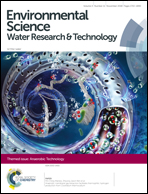Anaerobic membrane gas extraction facilitates thermophilic hydrogen production from Clostridium thermocellum†
Abstract
Clostridium thermocellum is among the most efficient bacteria to convert cellulosic biomass into H2 during dark fermentation. However, despite great progress the H2 yield and rate are still not satisfactory for large scale applications. The purpose of this study was to evaluate whether in situ gas extraction using membrane bioreactors would increase H2 production from Clostridium thermocellum when compared to a conventional anaerobic fermentation setup in thermophilic conditions. C. thermocellum DSM 1313, a cellulotyic, thermophilic bacterium was grown on cellobiose and Avicel in an anaerobic-fermenter (AF) and an anaerobic-membrane-bioreactor (AnMBR). Compared to the AF, the AnMBR increased cumulative H2 production by 63%, from 25.8 to 42.1 mmols, increased the max H2 production rate by 24%, from 3.4 to 4.2 mmol h−1, and increased yield by 58%, from 0.43 to 0.68 mmol H2 per mmol hexose, on cellobiose. Likewise, on Avicel, the AnMBR increased cumulative H2 production by 59%, from 46.8 to 74.6 mmols, increased the max H2 rate by 87%, from 3.1 to 5.8 mmol h−1, and increased the yield by 59%, from 0.76 to 1.21 mmol H2 per mmol hexose. These results show that anaerobic membrane gas extraction can be an effective approach to increasing both rate and yield of fermentative H2 production.

- This article is part of the themed collection: Anaerobic Technology


 Please wait while we load your content...
Please wait while we load your content...